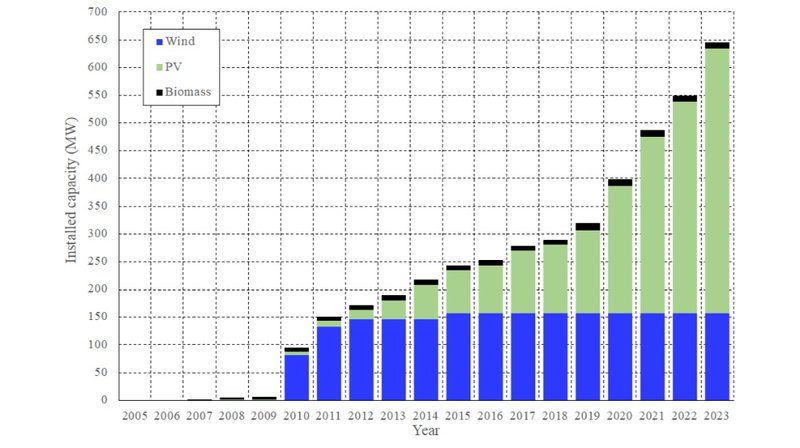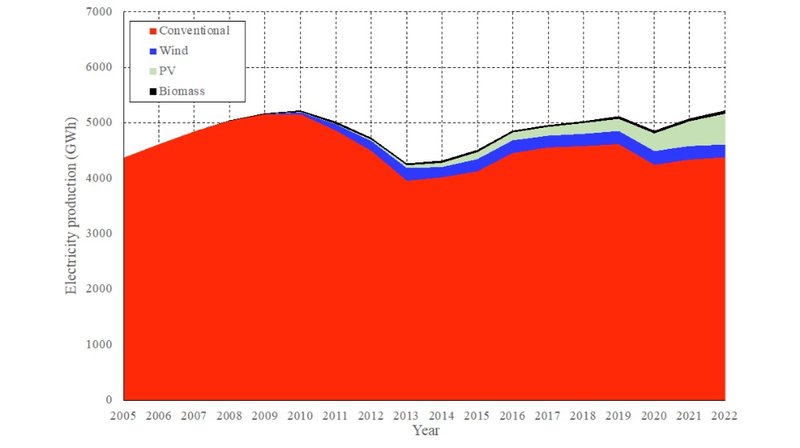Dr. Andreas Poullikkas, Chairman of the Cyprus Energy Regulatory Authority (CERA), discusses ways of ending the island’s energy isolation and transforming Cyprus into a model green country by 2050.
Let's start by discussing the benefits of ending the isolation of Cyprus' electricity systems.
Cyprus is an isolated island electricity system of significant size within the EU. It shares similarities in capacity and peak demand with Crete, Malta, and the Canary Islands, as well as Hawaii, Puerto Rico, Jamaica, and Trinidad and Tobago. Isolated systems face higher costs and uncertainty in electricity generation. As a rule of thumb, the smaller the isolated electrical system size, the higher the expenses. They also lack access to diverse technologies and cannot connect to continental grids like the European one. These systems rely heavily on oil derivatives due to the absence of natural gas, making them vulnerable to international oil market prices, and incur additional costs from the emissions trading scheme within the EU. At the same time, the limited unit size in power generation hampers economies of scale, and maintaining reserve capacity becomes essential due to system vulnerability. Another challenge is that isolated power systems lack the flexibility provided by interconnected grids. Interconnecting Cyprus’ electricity grid with neighbouring countries or the EU grid will overcome the above drawbacks – increasing electrical interconnections enhances the system’s reliability. This creates opportunities for increased flexibility in business activities and attracts new investments in electricity generation and other sectors. With proper planning, Cyprus can tap into its energy potential and become an electricity exporter, utilising interconnections like the EuroAsia and EuroAfrica Interconnectors. Cyprus can serve as a hub for electricity transfer between the EU, Israel, Egypt and, potentially, the Middle East in the long term. Moreover, electricity interconnections can increase Cyprus’ energy security.
Tell us more about the solutions through which Cyprus is trying to increase the flexibility of its electricity system. Which one do you believe will have the most long-lasting results?
Many available solutions can increase electricity system flexibility, both in the short and medium to long term. Short-term solutions, backed by existing regulations, involve natural gas technologies, RES and storage systems. Integrating RES and storage into the electricity market is crucial for flexibility. Furthermore, redesigning the power grid to be smart and bi-directional, allowing large RES quantities and energy storage systems, along with the widespread installation of smart meters, will contribute to flexibility. The Government should also promote e-mobility, especially vehicle-to-grid (V2G) technology, allowing bidirectional electricity flow between electric cars and the grid. Medium-term solutions involve establishing electricity interconnections, particularly with the EU internal market, as Cyprus is currently the only non-interconnected member state. The development of the first section of the EuroAsia interconnector, linking Cyprus to Crete and subsequently the EU market, would enhance flexibility for more RES. Finally, long-term solutions concern hydrogen production from natural gas and renewables.
In terms of RES, Cyprus is still below the EU average. What challenges does the country face in the efforts to increase total energy consumption drawn from RES and meet the 23% goal by 2030?

Figure 1 (cut-off data availability end of June 2023)
Figure 1 shows historical data concerning the annual installed capacity of RES since 2005. Currently, RES includes 476 MW of photovoltaic systems, 157 MW of wind parks and 13 MW of biomass technologies for a total of 646 MW. Conventional generation installed capacity amounts to 1,483 MW. In terms of installed capacity, the RES share is more than 40%.

Figure 2
Figure 2 shows historical data concerning the contribution to annual electrical energy production by different technologies since 2005. Due to the intermittency of RES, the overall contribution to final electricity demand in 2022 was around 21%. Over 1,000 MW of RES construction licenses have been granted by CERA. Nevertheless, key barriers include the electrical grid’s one-way nature and the response of conventional power generation technologies. These limitations lead to the curtailment of RES, especially during low electricity demand periods. As already mentioned, increasing system flexibility will allow greater RES integration, helping Cyprus to maintain its commitments to the EU.
In the transition toward the EU's climate-neutral goal by 2050, what role will alternative fuels like hydrogen play?
Hydrogen is expected to contribute to the exploitation of renewable and environmentally friendly energy sources and the development of similar new technologies. As an energy carrier, hydrogen addresses issues related to energy supply, renewable energy reliability, climate change and air pollution. Green hydrogen, produced from RES, can replace fossil fuels in heating, cooling, transport and electricity production, with only water and heat as by-products. In recent years, following the COVID-19 pandemic and the war in Ukraine, numerous countries are pushing for their long-term energy transition to achieve climate neutrality, with hydrogen as a key component of their future energy systems. Two factors, or rather challenges, delay the use of hydrogen: equipment durability and production cost. Today, science and technology have addressed equipment durability drawing from the manufacturing experience gained in solar and wind technologies. However, production costs, especially of green hydrogen, require further improvement. To achieve competitiveness, the aim is to reduce the current price of US$5 per kilo to about US$1.5 dollars per kilo. It should be noted that the EU has supported hydrogen research since 1989, with a steady increase in funding, and ongoing development of legislative measures and regulations.
What steps does Cyprus need to take to allow for the introduction of such fuels to the energy mix?
To introduce hydrogen into the energy mix, the Cyprus government should (a) recognise it as a key component for 2030 and up to 2050, (b) develop a long-term national energy strategy including hydrogen, (c) create a legislative framework for participation in the hydrogen market, (d) harmonise the national legislative framework with the relevant European Directives and (e) promote targeted measures to kick-start the hydrogen value chain across production, transport, storage and final consumption.
What best practices from abroad can be adopted to facilitate Cyprus' transition into a carbon-neutral economy?
To become more sustainable by 2050, the Government should align with the “Less carbon – more renewable energy sources and hydrogen” trend, adopted by many countries worldwide. This necessitates accelerating the country’s transition towards a low-carbon economy. With a proper plan, Cyprus can transform into a model green country by 2050. Cyprus could set a long-term target of achieving 100% greenhouse gas emissions by 2050. To achieve this objective, RES targets need to be set at 30% for 2030, 75% for 2040 and 100% for 2050. By 2050, Cyprus can establish a smart, digitised, flexible and interconnected energy system. This will include interconnected natural gas and/or hydrogen pipelines, using hydrogen across energy sectors, RES integration, energy storage systems and electrification. In the long term, these actions will pave the way for the development of a low-carbon economy.
Finally, how can Cyprus transform into an energy hub in the Mediterranean region, and what role will synergies with Israel, Greece and Egypt have in this transformation?
Leveraging its natural gas reserves in the South-Eastern Mediterranean and the interest in RES, Cyprus should pursue sustainable energy development. This can be achieved by effectively managing natural gas reserves and promoting sustainable growth for the benefit of future generations. The natural gas reserves in the South-Eastern Mediterranean can provide a transitory solution for Europe’s dependence on Russian natural gas until the energy transition is complete – a common long-term strategic plan, extending beyond 2050, can meet this goal. The plan will consider various factors, including (a) connecting South-Eastern Mediterranean countries with their European counterparts through electricity interconnections like the EuroAsia and EuroAfrica Interconnectors, (b) establishing natural gas pipelines and/or virtual pipelines, such as the EastMed project, (c) integrating sustainable energy technologies across the region, (d) utilising hydrogen from RES and natural gas reforming after 2030, exporting electricity, and (f) exporting hydrogen to European countries. By implementing this strategy, Cyprus can transform into an energy hub and the South-Eastern Mediterranean region can lead the way in pioneering a low-carbon economy and exporting sustainable energy to the EU.
This interview first appeared in the July edition of GOLD magazine. Click here to view it.


